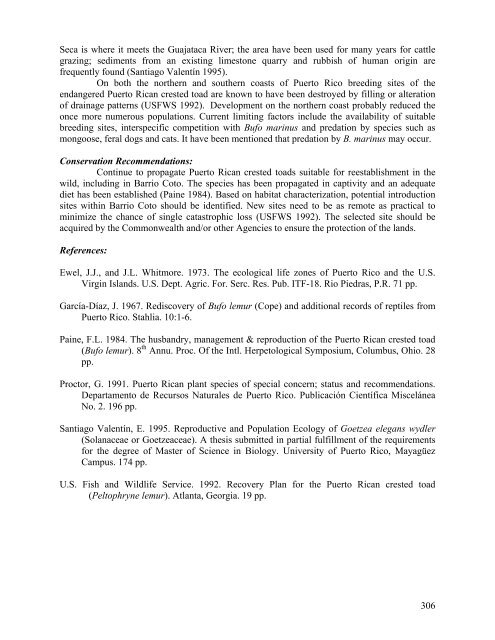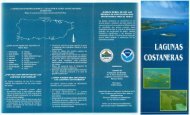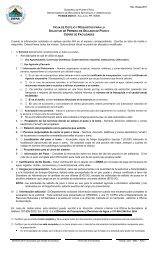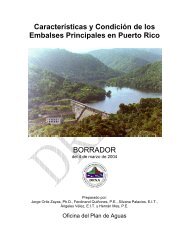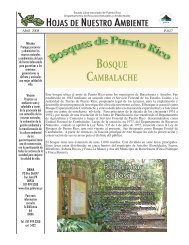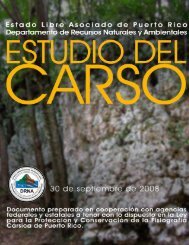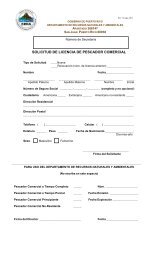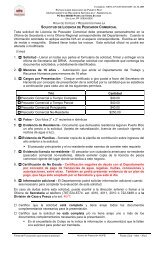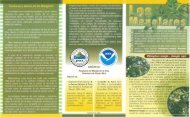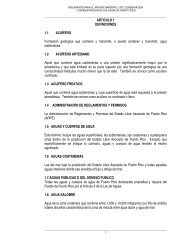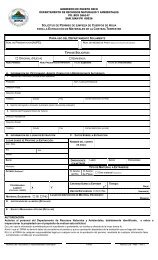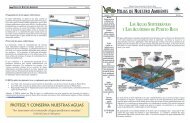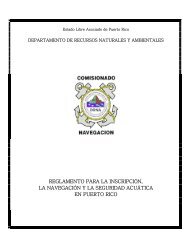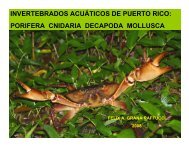- Page 1 and 2:
Puerto Rico Critical Wildlife Areas
- Page 3 and 4:
19) Larga Beach and Zoní Lagoon, C
- Page 5 and 6:
67) Monito Island ……………
- Page 7 and 8:
Dedicatory We honor to dedicate thi
- Page 9 and 10:
Introduction After twenty years fro
- Page 11 and 12:
Department of Natural and Environme
- Page 13 and 14:
collaris, American Wigeon A. americ
- Page 15:
Villanueva, E., L. J. Rivera-Herrer
- Page 19:
Birds in the Fort Buchanan Pond The
- Page 23 and 24:
designated a Natural Reserve in 197
- Page 25 and 26:
in the waters that enter through th
- Page 29 and 30:
4- Barrio Borinquen, Trujillo Alto
- Page 33 and 34:
5- Baja Swamp and Herrera River Mou
- Page 37 and 38:
6- Ensenada Comezón and Espíritu
- Page 39 and 40:
Echinodermata: Sea Urchin Eucidaris
- Page 43:
7- Río Mar, Street # 968, Río Gra
- Page 47 and 48:
Puerto Rican Lizard cuckoo Saurothe
- Page 51 and 52:
9- San Miguel, Las Paulinas and El
- Page 53 and 54:
From the 18 km. of monitored areas,
- Page 57 and 58:
10- Laguna Grande, Laguna Aguas Pri
- Page 61:
11- Fajardo Coastline, Fajardo, Pue
- Page 65 and 66:
Virgin Islands boa Epicrates monens
- Page 68 and 69:
13- Flamenco Peninsula, Culebra Isl
- Page 70 and 71:
Threats: The development of recreat
- Page 74 and 75:
16- Resaca Mountain, Culebra, Puert
- Page 76 and 77:
Hall, K. V. and A. D. Tucker. 1985.
- Page 78:
References: Aponte Pagán, M. 1981.
- Page 82 and 83:
The mangroves of Puerto Del Manglar
- Page 84 and 85:
23- Cementerio Bay, Culebra, Puerto
- Page 86:
Slippery-backed mabuya Mabuya mabou
- Page 90 and 91:
Mammals The seagrass beds in the we
- Page 92 and 93:
Birds at Playa Grande Lagoon Forty
- Page 96 and 97:
26- Ensenada Honda Mangrove, Vieque
- Page 100 and 101:
27- Yanuel Lagoon, Vieques Island S
- Page 104 and 105:
28- Chiva Swamp, Vieques Island Sou
- Page 106:
References Raffaele, H. A. 1972. Se
- Page 109 and 110:
30- Ferro Bay, Mosquito Bay, and So
- Page 111 and 112:
Seliger, H. 2001. Bioluminescence i
- Page 113 and 114:
105
- Page 115 and 116:
Conservation Recommendations: Becau
- Page 117 and 118:
109
- Page 119 and 120:
squatarola, Whimbrel Numenius phaeo
- Page 121 and 122:
113
- Page 123 and 124:
33- Ceiba State Forest, Fajardo, Ce
- Page 125 and 126:
117
- Page 127 and 128:
34- Humacao Natural Reserve, Humaca
- Page 129 and 130:
Crustaceans Callinectes marginatus,
- Page 131 and 132:
123
- Page 133 and 134:
35- Pandura Mountain Range, Yabucoa
- Page 135 and 136:
Valenciano Project Area, Juncos, Pu
- Page 137 and 138:
129
- Page 139 and 140:
Conservation Recommendations: The m
- Page 141 and 142:
133
- Page 143 and 144:
Birds Forty eight bird species have
- Page 145 and 146:
137
- Page 147 and 148:
38- Cerro El Gato and Associated Ar
- Page 149 and 150:
141
- Page 151 and 152:
39- Cidra Lake, Cidra, Puerto Rico
- Page 153 and 154:
145
- Page 155 and 156:
40- Aguirre State Forest, Punta Poz
- Page 157 and 158:
crowned pigeon Patagioenas leucocep
- Page 159 and 160:
Tarpon snook Centropomus pectinatus
- Page 161 and 162:
Coastal Resource Management. 1983.
- Page 163 and 164:
155
- Page 165 and 166:
D. petechia, Northern Waterthrush S
- Page 167 and 168:
159
- Page 169 and 170:
Northern parula Parula americana, B
- Page 171 and 172:
163
- Page 173 and 174:
noveboracensis, Royal tern Sterna m
- Page 175 and 176:
167
- Page 177 and 178:
Threats: There is a high pressure f
- Page 179 and 180:
171
- Page 181 and 182:
Birds in Berbería Cay Thirteen bir
- Page 183 and 184:
175
- Page 185 and 186:
46- Serrallés Lagoons Complex, Jua
- Page 187 and 188:
179
- Page 189 and 190:
47- Toro Negro State Forest, Ciales
- Page 191 and 192:
Conservation Recommendations: Manag
- Page 193 and 194:
185
- Page 195 and 196:
semipalmatus, Short-billed dowitche
- Page 197 and 198:
189
- Page 199 and 200:
Patagioenas squamosa, Mangrove cuck
- Page 201 and 202:
193
- Page 203 and 204:
50- Punta Verraco, Cerro Toro and P
- Page 205 and 206:
197
- Page 207 and 208:
51- Guayanilla Hills, Guayanilla, P
- Page 209 and 210:
201
- Page 211 and 212:
52- Guánica Lagoon, Guánica-Lajas
- Page 213 and 214:
acuta, Green-winged teal A. crecca,
- Page 215 and 216:
Guánica Lagoon Map obtained from M
- Page 217 and 218:
209
- Page 219 and 220:
Cave swallow Petrochelidon fulva, C
- Page 221 and 222:
213
- Page 223 and 224:
54- San Jacinto Salt Flats and Tama
- Page 225 and 226:
217
- Page 227 and 228:
55- Susúa State Forest and Adjacen
- Page 229 and 230:
221
- Page 231 and 232:
56- La Parguera Natural Reserve, La
- Page 233 and 234:
associated with tourism is destroyi
- Page 235 and 236:
227
- Page 237 and 238:
229
- Page 239 and 240:
ecause of its historic importance f
- Page 241 and 242:
In 1995, the USFWS initiated a chal
- Page 243 and 244:
235
- Page 245 and 246:
58- Boquerón State Forest, Lajas,
- Page 247 and 248:
Fish A study of fish abundance real
- Page 249 and 250:
59- Boquerón Wildlife Refuge, Cabo
- Page 251 and 252:
Antillean Grackle Quiscalus niger,
- Page 253 and 254:
245
- Page 255 and 256:
60- Cabo Rojo Salt Flats and Adjace
- Page 257 and 258:
Conservation Recommendations: Buffe
- Page 259 and 260:
251
- Page 261 and 262:
Greater yellowlegs Tringa melanoleu
- Page 263 and 264: 255
- Page 265 and 266: 62- Joyuda Lagoon Natural Reserve,
- Page 267 and 268: to the system. Other recommendation
- Page 269 and 270: 261
- Page 271 and 272: National Oceanic and Atmospheric Ad
- Page 273 and 274: 265
- Page 275 and 276: sandpiper C. pusilla, Royal tern St
- Page 277 and 278: SOPI. 2003. Avistamientos en la Ca
- Page 279 and 280: 271
- Page 281 and 282: Ownership/Protection: The Maricao S
- Page 283 and 284: _____ and _____. 1990. Lista prelim
- Page 285 and 286: 277
- Page 287 and 288: Advisory Council on Historic Preser
- Page 289 and 290: controlling the population. Surroun
- Page 291 and 292: _____. 1973. Pelagic life zone arou
- Page 293 and 294: 285
- Page 295 and 296: 67- Monito Island, Puerto Rico Area
- Page 297 and 298: Morales, D. 1985. Documento de Desi
- Page 299 and 300: 291
- Page 301 and 302: In addition to protecting water qua
- Page 303 and 304: 295
- Page 305 and 306: Conservation Recommendations: The C
- Page 307 and 308: 299
- Page 309 and 310: Scaly-naped pigeon Patagioenas squa
- Page 311 and 312: Meier, A. J.; R.E. Noble, and H.A.
- Page 313: 71- Barrio Coto, Isabela Area Descr
- Page 317 and 318: 309
- Page 319 and 320: 311
- Page 321 and 322: Wildlife: Birds Fifty seven bird sp
- Page 323 and 324: 315
- Page 325 and 326: 74- Guajataca Lake, Isabela-San Seb
- Page 327 and 328: 319
- Page 329 and 330: 75- Barrio Cocos and Bellaca Creek,
- Page 331 and 332: Santiago Valentín, E. 1995. Reprod
- Page 333 and 334: 325
- Page 335 and 336: 327
- Page 337 and 338: Amphibians White-lipped frog Leptod
- Page 339 and 340: 331
- Page 341 and 342: Wildlife: With one hundred and nine
- Page 343 and 344: springs to manage salinity levels w
- Page 345 and 346: 337
- Page 347 and 348: 339
- Page 349 and 350: Prairie warbler D. discolor, Ovenbi
- Page 351 and 352: 343
- Page 353 and 354: 345
- Page 355 and 356: Amphibians Antillean coqui Eleuther
- Page 357 and 358: 80- Hacienda La Esperanza Natural R
- Page 359 and 360: Threats: Some areas are susceptible
- Page 361 and 362: 353
- Page 363 and 364: Wildlife: Birds at Tortuguero Lagoo
- Page 365 and 366:
Grana Raffuci, F. A. 2000. Letter t
- Page 367 and 368:
359
- Page 369 and 370:
tanager Spindalis portoricensis, Ye
- Page 371 and 372:
363
- Page 373 and 374:
83- Vega State Forest, Vega Baja-Ve
- Page 375 and 376:
367
- Page 377 and 378:
84- Lakes and Forests of Dorado, Do
- Page 379 and 380:
371
- Page 381 and 382:
85- Mogotes Río Lajas and Nevárez
- Page 383 and 384:
375
- Page 385 and 386:
References: None available 377
- Page 387 and 388:
87- San Pedro Swamp, Toa Baja Area
- Page 389 and 390:
_____.2004. NPL Listing History. EP
- Page 391 and 392:
383


